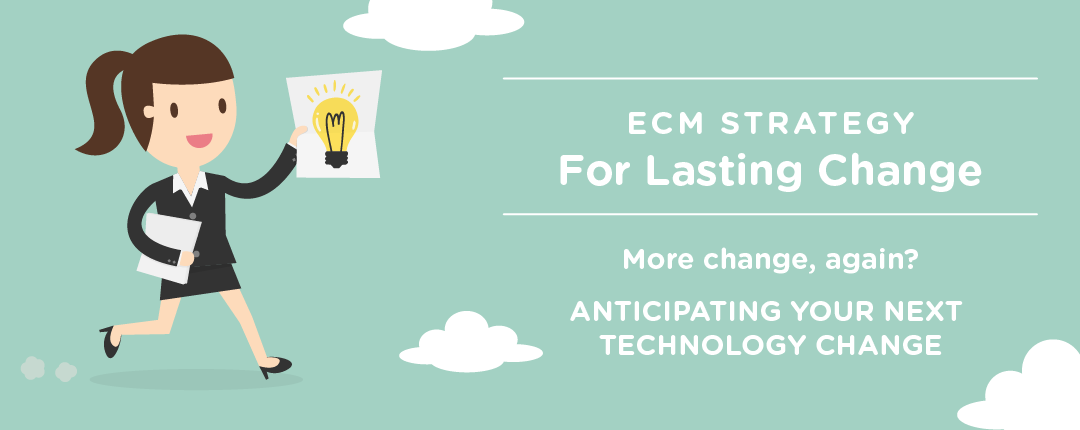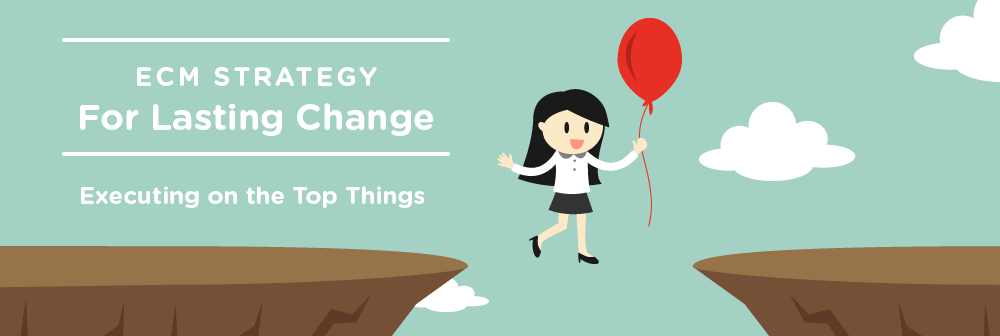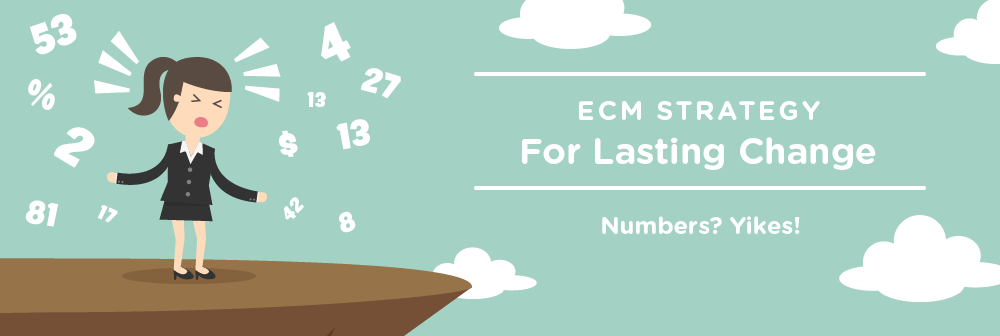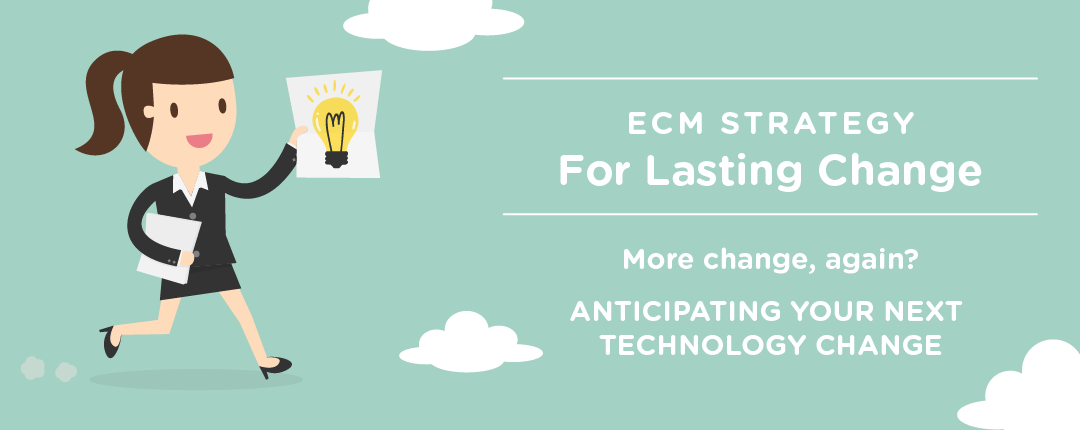Anticipating your next technology change
This article, the fourth in a five part series on technology strategy techniques, discusses how to be successful through all kinds of business and technology changes. If you haven’t read the series, find the additional posts here.
“It must be considered that there is nothing more difficult to carry out, nor more doubtful of success, nor more dangerous to handle, than to initiate a new order of things.” — Niccolo Machiavelli, “The Prince”
I’ve seen this quoted in various settings before. Machiavelli wrote these words in the early 1500s to provide advice—his rant being potentially harmful or immoral—to a new prince attempting to establish rule in the 16th century. Yet today, in the minds of leaders who are driving strategic initiatives across the corporate landscape, these simple words continue to carry cautionary weight. Modern technological change is ongoing and when it comes to your ECM platform or any large enterprise system, the preparation, planning, and continuous management through change is key to the health of your systems and team members.
In the other articles of this blog series, I’ve focused on planning, implementing, and measuring ECM “projects.” However, once the main rollout project is complete, many things bring about change in an ECM platform. Many argue that if your ECM platform isn’t changing, it’s probably slowly dying! So continuous change is key to its survival. How can you ensure your ECM platform can adapt to change and continue to thrive? Here’s a few key things to keep in mind.
First, ensure your house in order. The best way to know how to deal with change is to know what you have in the first place. Think of this one as essentially saying, “OK, what have we got and how is it performing?”
You should regularly conduct health checks of the ECM that include everything from hardware and software, to network systems and integrated platforms. This allows you to see and know what you have and, more importantly, what you may lack. With any pending change, you’ll be better informed on where and how that change could affect what you have in place. (And whether that change is even a good thing!) Knowing your baseline also helps you to understand whether a change itself is impacting your system or if there were other things going on with your platform before changes were introduced.
Strategy Desk Tip: Zia Performs Health Checks Zia offers a Health Check engagement provided by an experienced engineering consultant which analyzes your existing hardware and software environments running Alfresco and/or Ephesoft platforms. The engagement looks into pain points, resource usage, scalability, troubleshooting common system issues, and makes recommendations for improvements. Depending on your environment and current installed solution, the health check may provide:
- Architectural diagrams and validation
- Hardware architecture
- Supported platforms and versions validation
- Repository health
- Database validation
- Index statistics
- Memory validation
- Log file analysis
- Add-ons, customizations, or extensions review (high level)
- Backup and restore procedures
At the end of the health check, you will be provided with a summary of your environment, feedback, and follow-up recommendations to identify and prevent any potential issues on the systems.
Next, be prepared, by having a seat at the table. The best way to know that change is coming or—better yet—to guide how change comes to your team is to know what the other teams across your organization are doing. As an IT executive, architect, or specialist, being involved at discussions during regular business strategy meetings allows you to hear about things that could impact the ECM either near-term or long-term. Sometimes, it’s just a matter of listening in. Other times it’s a matter of asking the right questions that others, who are not as in-tune to the finer points of ECM, may not know to ask.
Take the example of upgrading or rolling out a new business system like a customer relationship management (CRM) system. Perhaps the ECM team isn’t involved with the technology choice, planning, or rollout of the CRM. However, when a business team member mentions that they’ll just be storing customer contracts in the CRM because it has a content management module, your ears should perk up. This is certainly a topic to discuss and understand with the right folks at the table. There may or may not be a right or simple answer, but I’ve heard more than one story where it would’ve been easier to discuss ECM integration points near-term rather than an intensive and costly migration of content years later.
Simply “listening in” to discussions with business teams can help guide the right change to be brought to the ECM platform and weave it into your overall strategic vision. You don’t need to make every conversation into an ECM conversation! Just think about how the ECM weaves into, or is impacted by, the other systems and platforms within your enterprise. This keeps your platform adapting with the business.
Lastly, prepare your platform for growth. One of the ways change sneaks up on your ECM platform is growth.
Wait, when did the system regularly start ingesting 50,000 new documents per hour!?
If the platform isn’t prepared for growth, it certainly isn’t prepared for the change that is required as a result of that growth. Remember, growth is an awesome problem to have, as long as you are ready. Your team and platform need to be aligned to deal with new customers and volumes.
Make sure you know what your system is capable of and what differentiates it as a platform. You should be able to articulate how the platform should and should not be used. This drives decisions that affect how your ECM platform is managed overall. If you haven’t already, you should write down a set of guiding principles for the ECM that are its “differentiating capabilities”. These capabilities guide areas of growth for the ECM and are areas that are regularly pursued for growth, while areas that don’t fit are resisted. Then align your budgets, spending, and cost cutting with those capabilities.
Strategy Desk Tip: Guiding Principles Guiding principles for your ECM should compliment your overarching enterprise goals and echo the business value you are driving with your platform. These principles could be looked at like high-level rules that are followed to guide the architectural implications of investment and design decisions. Example of some ECM-related principles:
- Reflects vision of improved ways of using technology to benefit business
- Reflects high-level business and IT requirements in a commonly understood way
- Delivers the right content at the right time, to support decision-making in the right business application
- Creates a customer-focused environment supporting multi-channel content delivery
- Enforces regulatory requirements such as records and archival management
Your guiding principles might be different but, in order to be meaningful, principles need to be shared and authorized. This takes time. You may want to set up a team or working group to handle building and sharing your principles.
And of course, plan big picture goals with realistic resourcing plans to match. Know what you want to keep—and why. Know what you want to change—and how. Always set clear, achievable plans and deadlines for executing on new changes, and manage through the complexities and challenges to keep moving forward. The key is showing that your platform can undertake change and get stronger, instead of falling apart.
Change comes in all shapes and sizes. Perhaps the change on your team’s horizon is daunting, such as managing large migrations through a sizable merger or acquisition. Or maybe it’s subtle, where current business teams require a few key enhancements so they can work more efficiently. Either way, hope for sliding through change with a stable platform isn’t enough! Prepping, shaping, recognizing, and getting in front of change allows you to attack it and reap the benefits.
To speak with our knowledgeable team and find out how an assessment can help you determine the best avenue for your ECM challenges, contact us today. In the next installment, we’ll discuss how to sustain technology success.






